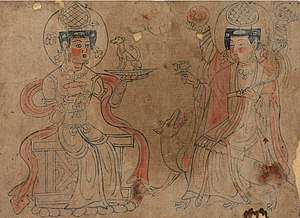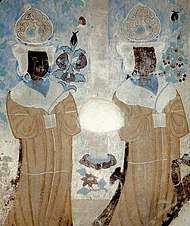Sogdian Daēnās
Sogdian Daēnās,[1] also known as Sogdian Deities[2] (French: Deux divinités féminines; Chinese: 粟特神祇白畫) is a 10th-century line drawing discovered by the French Orientalist Paul Pelliot at the Mogao Caves. It was painted during the late Tang dynasty and the Five Dynasties and Ten Kingdoms period, and is probably associated with the Zoroastrian cult of the Sogdian people. The historian Zhang Guangda, who is a member of the Academia Sinica of Taiwan, recognised this "paper image" as one of the "pieces of paper depicting Mazdean deities for the saixian celebration".[note 1][4] The drawing is preserved in the Bibliothèque nationale de France in Paris.
| Sogdian Daēnās | |
|---|---|
| Chinese: 粟特神祇白畫, French: Deux divinités féminines | |
 | |
| Artist | Unknown |
| Year | 10th century |
| Type | Ink with light colouring on paper |
| Dimensions | 30.5 cm × 37.8 cm (12.0 in × 14.9 in) |
| Location | Bibliothèque nationale de France, Paris |
Description
This sketch, painted on paper in black ink with light colouring, depicts two ladies sitting opposite each another, their heads being encircled by nimbi. Both are represented holding various attributes: the lady on the left, who sits on a rectangular throne supported by a row of lotus petals, holds a foliated cup and a tray with a dog seated on it. The one on the right is seated on a dog or wolf, and has four arms, the upper two supporting the sun and moon discs, the lower two arms holding a scorpion and a snake. They wear a characteristic hairstyle, surmounted by a water-drop-shaped or peach-shaped headdresses that are probably made of metal.[2]
Analysis

The drawing had been published in Jao Tsung-I's The Line Drawing of Dunhuang in 1978, but has only attracted the interest of researchers since it was displayed in the Sérinde exhibition in 1995.[2]
The peach-shaped headdress resembles the hairstyle of the Uyghur princess. The dress of the lady on the left, at least, does not seem to correspond to the Chinese fashion at the time, and both representing the expression of foreign beliefs.[5]
According to Jiang Boqin (姜伯勤)—a professor at Sun Yat-sen University—it is a piece of Zoroastrian art, and the four-armed deity is a Sogdian goddess worshipped in their Zoroastrian cult, whose name is Nanâ, or Nanaia,[6] the goddess originated from Mesopotamia.[7] Frantz Grenet—a French specialist on Sogdiana and Zoroastrianism—and the historian Zhang Guangda argue that the lady on the left representing Daēnā, the good according to Zoroastrian vision; the other one represents Daēva, the bad.[1] Jiang Boqin agrees with Grenet and Zhang that the deity on the left being Daēnā, but he determined the one on the right is the goddess Nanâ.[8]
Notes
References
- Williams, Alan; Stewart, Sarah; Hintze, Almut, eds. (2016). The Zoroastrian Flame: Exploring Religion, History and Tradition. London: I.B.Tauris. ISBN 9780857728869.
- Russell-Smith, Lilla Bikfalvy (2003). "Wives and Patrons: Uygur Political and Artistic Influence in Tenth-century Dunhuang". Acta Orientalia Academiae Scientiarum Hungaricae. 56 (2/4): 411. Retrieved 22 November 2018.
- Rong, Xinjiang (2013). Eighteen Lectures on Dunhuang. Translated by Galambos, Imre. Leiden: Brill Publishers. p. 73. ISBN 9789004252332.
- Drège, Jean-Pierre (2007). Études de Dunhuang et Turfan [Dunhuang and Turfan Studies] (in French). Geneva: Librairie Droz. p. 64. ISBN 978-2-600-01132-7.
Zhang Guangda voit dans les dépenses de « papier à image » en rapport avec le culte mazdéen des feuilles « de papier pour peindre les divinités mazdéennes destinées au saixian ».
- "Cote : Pelliot chinois 4518 (24) – Deux divinités féminines". archivesetmanuscrits.bnf.fr (in French). Retrieved 22 November 2018.
Elle ressemble à la coiffure de la princesse ouïghoure.
- Wu, Yu (2004). "姜伯勤《中國祆教藝術史》書評" (PDF). schina.ust.hk (in Chinese). Retrieved 22 November 2018.
- Gorshenina, Svetlana; Rapin, Claude (2001). "Chapitre 5 : Des Kouchans à l'Islam – La peinture sogdienne". De Kaboul à Samarcande : Les archéologues en Asie centrale. Collection "Découvertes Gallimard" (in French). 411. Paris: Éditions Gallimard. p. 107. ISBN 978-2-070-76166-1.
Dans la peinture on rencontre ainsi des versions du Panchatantra, l'histoire de la déesse Nana originaire de Mésopotamie.
- Wang, Xusong (2013). "敦煌與中外關係史研究三十年". xjass.cn (in Chinese). Retrieved 22 November 2018.
External links
- Pelliot chinois 4518 (24) : Deux divinités féminines at BnF archives et manuscrits (in French)